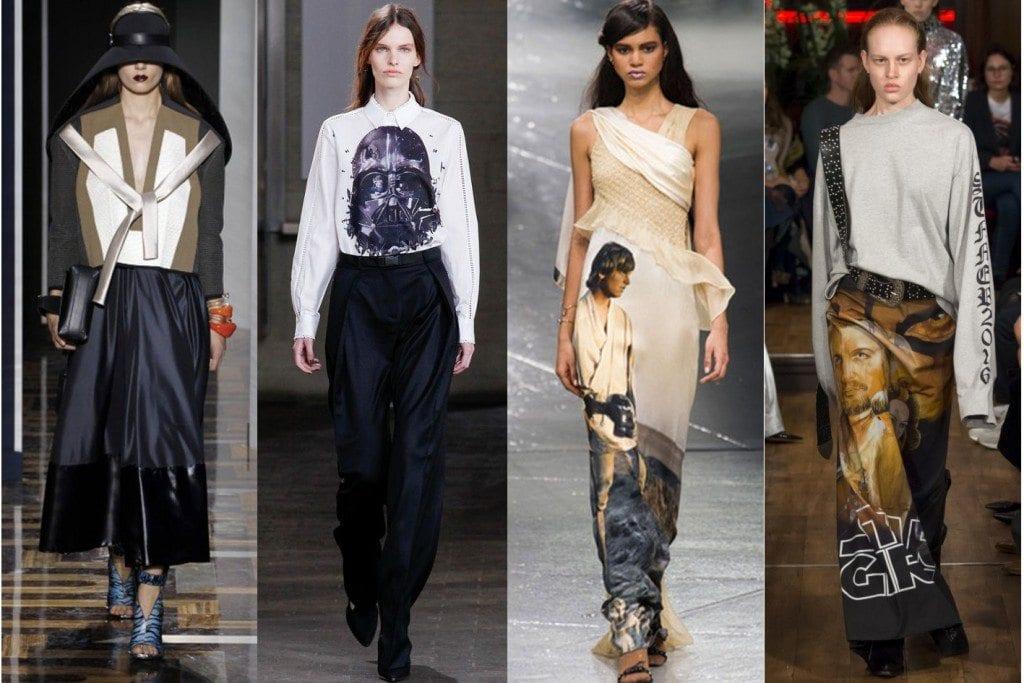Barbarella, Matrix, Hunger Games When the cinema imagines the fashion of the future<
While the Film Festival is in full swing until July 3, this year we are also celebrating the 20th anniversary of the film Matrix. The opportunity to look into the vision of fashion - of the future - that the 7th art has. Extravagant outfits, crazy hairstyles and futuristic accessories: science fiction films have often shown out-of-the-ordinary looks.
For Jean-Michel Bertrand, consultant at the French Fashion Institute (IFM), these feature films have even had an impact on today's trends: "Costume designers are fashion designers insofar as they are quoted by all the great fashion designers. Whether it's Mad Max that inspires Hedi Slimane's jackets at Saint Laurent or Star Trek honored by Gucci, cinema is a breeding ground for inspiration."
However, when you look at the most recent sci-fi movies, the look of the future looks more like a survival style, almost unisex. Like the costumes of the heroes of The Hunger Games (2012), Divergent (2014) or The Labyrinth (2014), post-apocalyptic films for teens, the outfits above all reflect the normcore and gender fluid trend of the 2010s. Is this plunge into current trends to imagine the look of the future specific to this period of the 2000s or has it always been present among costume designers? Decryption.
Miniskirts and laser guns
In the 1950s, at the time of B movies, a new style emerged on the small and big screen. Science fiction creations depict a futuristic world full of aliens, ultrakitsch robots, young women in distress and men with lacquered hair dressed in military costumes. Space outfits that are still made fun of today in series like Black Mirror. Forbidden Planet by Fred McLeod Wilcox (1956) marvelously embodies this universe punctuated by the “cheep, peep” of laser guns. In 2013, this film was also selected by the National Film Registry of the American Library of Congress to be labeled as "culturally, historically and aesthetically important".
http://t.co/I6Ot9N45 How To Install Glass Wall Blocks | Do It Yourself Home Repair And ... $
— Grayson Charter Wed Oct 19 17:08:08 +0000 2011
This new genre took on another dimension in the 1960s with the advent of the miniskirt. This iconic garment - popularized by André Courrèges - interferes in the costumes of heroines. Paco Rabanne himself notably worked on Jane Fonda's sexy wardrobe in Roger Vadim's film Barbarella (1968). Outfits often present at that time in the street, but not necessarily necessary in the hostile worlds of the future... Joëlle Moulin, art and cinema historian, characterizes this cinema "of Sputnik aesthetics". “At that time, there was a dream of leaving Earth, of going into space, especially among the Russians - hence the term Sputnik. This new wave of couturiers like Paco Rabanne, André Courrèges and Pierre Cardin used metals in their clothes, white colors, they were inspired by the galaxy… They are inventors in tune with the times.”
In pictures, these clothes that have become cult thanks to cinema
False look of the future?

In the 1970s, stop at the brilliant. No more sexy outfits and kitsch costumes: science fiction films are calming things down and entering a new era. With George Lucas' Star Wars saga which began in 1977 or Michael Anderson's Crystal Age (1976), the look of tomorrow is more sober. The women wear draped and immaculate dresses while the men wear plain outfits. Silhouettes evoking the hippie period of the 1970s which must have unconsciously entered the minds of the directors and costume designers of the time.
Same observation in the 1980s. Blade Runner (dating from 1982 but supposed to take place in 2019) and Back to the Future II released in 1989 (and taking place in 2015) are far from representing the fashion of the future. Wide shoulder pads or even tight skirts: in the two feature films, the style is very eighties and close to that of Madonna or Grace Jones. And even if Nike wanted to bring out Marty McFly's self-lacing sneakers, they were more of a collector's item than a real trend in the 2010s.
The 1990s, too, adapted to their filming dates. The iconic outfits of The Matrix (1999) and The Fifth Element (1997) borrow from the nineties aesthetic and above all grunge, from the openwork jumpsuit of Milla Jovovich to the total black look of Keanu Reeves. In the same vein, Tank Girl (1995), with Naomi Watts, as well as Kika (1993) by Pedro Almodóvar - which is not a futuristic film but includes costumes intended as such and designed by Gaultier and Versace - stage cult silhouettes of the decade.
What to wonder if we can really guess what we will wear in decades through the cinema of anticipation. Are the directors capable of completely freeing themselves from the stylistic codes of their time?
In video, a style, a film, the special Cannes 2019 portfolio
A lack of imagination?
Professor Jean-Michel Bertrand links this systematic resemblance of the looks of the future with contemporary trends to the very essence of fashion: "As in all creation, there there is not necessarily a total break with the existing. We are necessarily inspired by what has been. In films like fashion shows, we radicalize the look to give it character.
The parallel between today's fashion and that of futuristic films is a debate that goes far beyond the talent of costume designers, but challenges the very concept of the creative process. For several decades, most couturiers have been inspired by the past in order to reinscribe it in the present, and only a handful of designers (like the designer Iris Van Herpen) completely break the codes of clothing. So certainly, if we have fun today with the bad predictions of Back to the Future II, our grandchildren will surely laugh when they watch the films of our generation… on their iPhone 3000.


 Tags:
Tags: Prev
Prev







